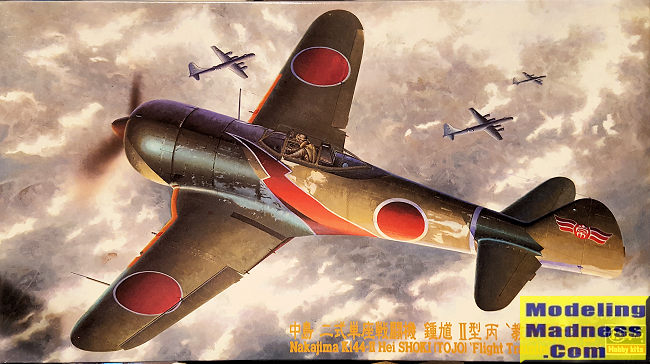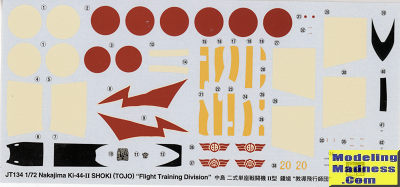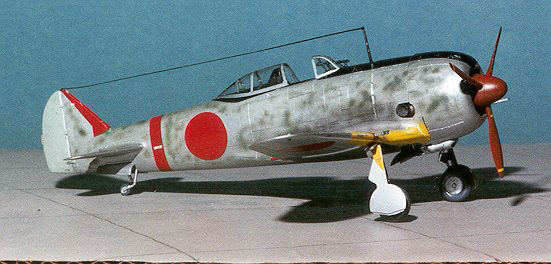
Hasegawa 1/48 Ki-44-IIhei 'Flight Training Division'
| KIT #: | 09194 (Jt134) |
| PRICE: | 2200 yen when new |
| DECALS: | Two options |
| REVIEWER: | Scott Van Aken |
| NOTES: | 1997 boxing |

| HISTORY |
The Nakajima Ki-44 Shōki (鍾馗) ("Demon Queller") was a single-engine fighter aircraft used by the Imperial Japanese Army Air Force in World War II, first flying in August 1940 and entering service in 1942. The Allied codename was "Tojo"; the Japanese Army designation was "Type 2 Single-Seat Fighter" (二式単座戦闘機).
In contrast to its predecessor, the nimble Ki-43, the Ki-44 was designed for speed and climbing ability and was used to intercept high-flying B-29 Superfortress bombers. With its poor visibility on the ground, weak armament, and high landing speed, it was generally disliked by pilots.
The pre-production Ki-44 aircraft and two of the prototypes were turned over to the Army for service trials on 15 September 1941. The type commenced operations with one experimental unit, the 47th Chutai (Independent Air Company) ("Kawasemi Buntai", Kingfisher Unit) sent to Saigon, Indochina in December 1941 with nine aircraft under the command of Major Toshio Sakagawa.
The unit later became the 47th Sentai, when flying home defense in Japan. More aircraft were later sent to China, and others were used in defense of oil wells in Sumatra, Indonesia, the China-Burma-India theater of operations, Philippines, Japanese metropolitan defense, mainly concentrated around Japan's large industrial cities and even kamikaze operations in the last stages of the war.
The 2c version "Tojos", armed with heavy cannon, were used against B-29s by one special kamikaze unit (a company of four aircraft minimum) of the 47th Sentai, which specialized in bomber collision tactics, the Shinten unit ("Shinten Seiku Tai"(Sky Shadow) 47th Sentai (Air Regiment) based at Narimasu airfield), during the defense of Tokyo.
The Nakajima Ki-44 at one point equipped 12 sentais of the Japanese Army Air Force (the 9th, 22nd, 23rd, 29th, 47th, 59th, 64th, 70th, 85th, 87th, 104th and 246th Air Regiments) which saw action before their (partial) replacement with Ki-84 Hayates for the final battles of the war. The Manchoukouan Air force also received some examples of these aircraft during wartime.
After World War II, the Nationalist Chinese 18th Squadron of the 12th Fighter Group was equipped with Ki-44s formerly of the 9th Sentai, which had disbanded in Nanking, and of the 29th Sentai, which had disbanded at Formosa and they participated in the Chinese Civil War. The People's Liberation Army Air Force managed to get hold of aircraft formerly belonging to 22nd and 85th Sentai, who had disbanded in Chosen, the Japanese name for Korea during their imperial rule (1910-1945) over that country. These aircraft were flown by Japanese nationalist pilots, who used them until the last two Ki-44s finally retired in the early 1950s.
| THE KIT |
 This kit was
initially released in 1995 and has had multiple re-issues, some with new parts
and all with new decal options. There have even been a few fantasy releases
based on anime or manga series, which seem to sell very well in Japan.
This kit was
initially released in 1995 and has had multiple re-issues, some with new parts
and all with new decal options. There have even been a few fantasy releases
based on anime or manga series, which seem to sell very well in Japan.
Though the tooling has been around for thirty years, this is still the best kit of the type in this scale. you are provided a nice cockpit that also provides a decal for the instrument panel. There is side wall detailing and if you want more, there are aftermarket sets for it. The engine is more than adequate as you won't see all that much due to the large prop spinner. The prop has separate blades
After installing a few interior sidewall bits along with the tail wheel well and interior, the fuselage halves are closed. This is followed by the wings, tailplanes and an upper cowling bit. Thankfully, Hasegawa molds the engine cowling as a single piece. The prop is held in place by a polycap installed during engine construction so it can be left off until after painting.
You are offered the chance to install wing tanks, though there are no flashed over holes to open so you'll have to do it from the outside. There are small depressions showing where to drill the holes. Landing gear and doors are well done, though the main gear are a tad complex so pay attention when installing these. Last bits are the usual gun barrels, antennas, etc along with a two piece windscreen/canopy that allows the canopy to be posed open. You have two windscreen options, one with a gun sight that sticks through it that is used by one of the markings options.
 Instructions
are standard Hasegawa fare that uses Gunze paint references. Two units are
provided on the decal sheet. One is the box art plane from the Hitachi Flight
Training Division. The other is from the Akeno unit and this plane is in overall
unpainted metal. The decal sheet is nicely printed though I'd recommend painting
on the white 'bandages' and the yellow wing ID area as the latter is fairly
complex and the decals don't seem to conform well to these areas. The upper
fuselage anti-glare decals worked well on a previous build, but you may want to
paint that area as well. Your choice.
Instructions
are standard Hasegawa fare that uses Gunze paint references. Two units are
provided on the decal sheet. One is the box art plane from the Hitachi Flight
Training Division. The other is from the Akeno unit and this plane is in overall
unpainted metal. The decal sheet is nicely printed though I'd recommend painting
on the white 'bandages' and the yellow wing ID area as the latter is fairly
complex and the decals don't seem to conform well to these areas. The upper
fuselage anti-glare decals worked well on a previous build, but you may want to
paint that area as well. Your choice.
| CONCLUSIONS |
I built one of these many, many years ago and generally found it to be a pleasant experience. I did have issues with the wing leading edge decals fitting properly, which is why I recommend painting this area. Here is a photo of that build.

April 2024
Copyright ModelingMadness.com. All rights reserved. No reproduction in part or in whole without express permission from the editor.
If you would like your product reviewed fairly and fairly quickly, please contact the editor or see other details in the Note to Contributors.
Back to the Main Page Back to the Review Index Page Back to the Previews Index Page